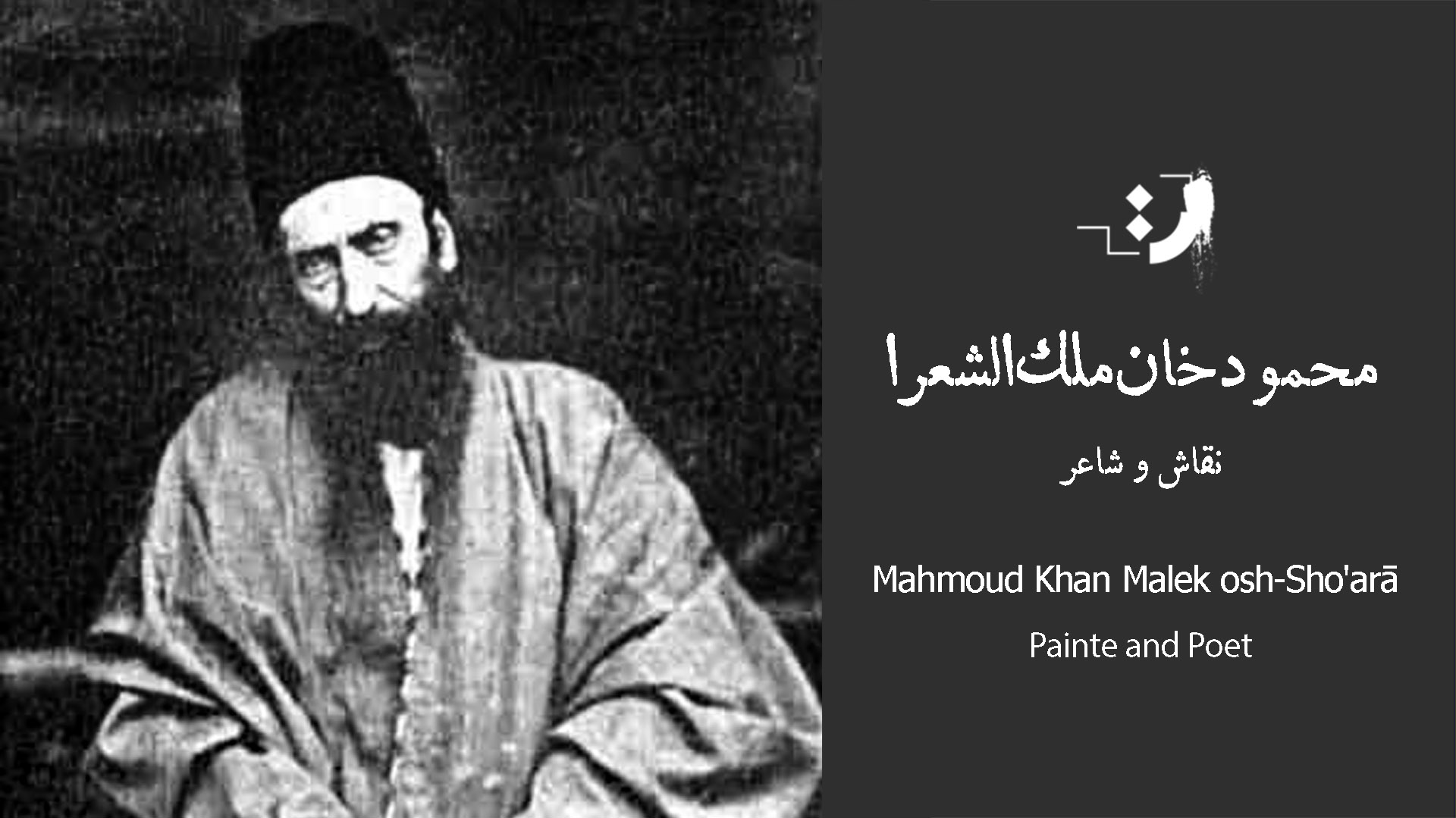Mahmud Khan Malek al-Shoara

Biography
Mahmud Khan Malek al-Sho’ara ; 1813–1893/94, was a poet laureate, court painter and statesman in 19th-century Qajar Iran. He was the son of Andalib and grandson of Fath-Ali Khan Saba, the previous poet laureates in the Iranian court.
Mahmoud Khan Malek al-Sho’ara (1228 AH – 1311 AH), known as Mahmoud Khan Saba and perhaps titled “Sharif,” was a poet and artist during the Qajar and Nasserian periods. In addition to poetry, he was skilled in painting and calligraphy. He excelled in penmanship, sculpture, and some other fields of handicrafts, but he is most renowned for his watercolor and oil paintings.
He was the son of Mohammad Hossein Khan Malek al-Sho’ara, known as Andalib, and the grandson of Fath Ali Khan Saba’i Kashani (the poets laureate of the Fath Ali Shah Qajar court) and was born in Tehran.
The ancestors of Fath Ali Khan Saba belonged to the Kurdish family of Kundanluj “Dunbuli” in Azerbaijan, who still reside in Tabriz, Khoy, and their surroundings. From the Safavid period onwards, most rulers of Azerbaijan were chosen from this family, and many brave, patriotic, and knowledgeable men emerged from among them.
Fath Ali Khan’s maternal uncle, Amir Ghiyas Beg, who was a renowned commander during the Safavid era, was killed in a battle due to a mistake made in commanding the army, resulting in the death of a group of talented youth from the Dunbuli family. Devastated by the loss of his brother, Amir Morteza Gholi Khan Dunbuli, and ashamed of his son’s death, he did not return to Azerbaijan and became secluded in Kashan, where he passed away in 1146 AH.
His son, Aqa Mohammad Zarabi, a contemporary of Nader Shah and Karim Khan Zand, remained in Kashan after his father’s death and took over the city’s mint, becoming known as Zarabkhaneh (the minter) of Kashan.
His son, Fath Ali Khan, was initially associated with the court poets of Lotf Ali Khan Zand and later joined the Qajar court. During Fath Ali Shah’s reign, he held the position of the poet laureate in the courts and governments of Qom, Kashan, Saveh, Naraq, and the vicinity of Jooshqan and Natanz to Isfahan.
After Fath Ali Khan’s death, Malek al-Sho’ara inherited his father’s position as the poet laureate of the court of Fath Ali Shah and Mohammad Shah. Besides being a poet, he also had expertise in handicrafts. He passed away in 1265 AH, during the reign of Naser al-Din Shah.
Andalib had three male descendants:
Mirza Jafar Khan Sadrol-Hokama, who received the title after his father Malek al-Sho’ara;
Mirza Ali Khan, who was inspired and educated in painting by his father and most of his works are watercolors, some of which are in the royal library and private collections;
Mirza Ahmad Khan;
Mirza Mehdi Khan.
While Mahmoud Khan’s poetic works are few, his prose and written works are also very rare because this great artist and scholar devoted all his time day and night to acquiring knowledge, studying, and creating artistic works. He did not have enough time for writing and compiling. Among his writings, only a few samples are available, including an introduction to “Maneshat-e Ghaem-Magham,” which was published in Tehran and Tabriz, and two other samples published in the “Keshkool-e Farhad Mirza.”
“Etmaad al-Saltaneh in Al-Ma’athir wal-Aathaar” (written in 1306 AH) is a work in which he was engaged in writing a book on the biographies of the titled individuals of that time under the order of Naser al-Din Shah. However, apparently, he was not entirely successful, and now nothing remains of it.
Mahmoud Khan created precise and accurate images of the buildings of his time. The fine quality and brilliance of some of these works were unprecedented, and his pointillist style was also unparalleled. However, his peak of innovation can be seen in his oil paintings, known as “Stantakh” (around 1272 AH). This work was not only a fresh and unique piece at that time but can also be considered a prototype for contemporary modern painting. Among his other works are the “Badi-e” Mansion (1278 AH), the view of “Almasiye Street” (1288 AH), the “Golestan Palace” (1297 AH), and the courtyard of the “Astaneh Hazrat Reza” (1303 AH). Most of these works are on display in the Golestan Palace Museum for the public to see.
Mahmoud Khan Malek al-Sho’ara also left remarkable works in calligraphy. He mastered Nasta’liq and broken Nasta’liq scripts and left behind some exquisite and artistic works in black calligraphy.
“Mahmoud Khan was a vegetarian.”
- Birthday: 1813
- Death: 1893-4
- Birthplace: Tehran, Tehran, Iran
Painter and Poet
